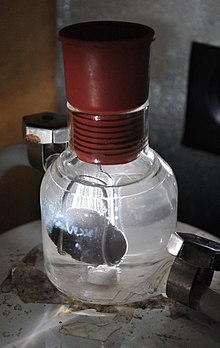Photocatalysis

When we talk about photocatalysis we are referring to a catalytic reaction that involves the absorption of light by a catalyst or substrate.
In chemistry, photocatalysis is the acceleration of a photoreaction in the presence of a catalyst. In photogenerated catalysis, photocatalytic activity (PCA) depends on the ability of the catalyst to create electron-hole pairs, which generate free radicals (e.g. hydroxyl radicals: • OH) capable of undergoing secondary reactions. Its practical application was made possible by the discovery of the electrolysis of water by means of titanium dioxide. The process used commercially is called the advanced oxidation process (AOP). There are several ways that AOP can be carried out, which may (but do not necessarily) involve TiO 2 or even the use of UV light. In general, the defining factor is the production and use of the hydroxyl radical.
During the photocatalytic process, as explained below, both oxidation and reduction reactions occur, so photocatalysis can not only be applied to the oxidation of organic compounds, but also to the reduction of inorganic ions and to the reduction of other organic compounds.
Photocatalytic process
Photocatalysis involves the combination of photochemistry with catalysis. Both light and catalyst are necessary to achieve or accelerate a chemical reaction. Thus, photocatalysis can be defined as the acceleration of a photoreaction using a catalyst.
The initial stage of the process consists of the generation of an electron-bone pair in the semiconductor particles. When a photon with energy E=h.. {displaystyle E=hnu }that equals or exceeds the energy of the semiconductor's band leap, Eg{displaystyle E_{g}}an electron is promoted, and-, from the valence band to the driving band, generating a hole, h+, in the valence band. The forbidden band energy is defined as the energy difference of the valence band and the driving band of a photocalyst.
Types of photocatalysis
Homogeneous photocatalysis
In homogeneous photocatalysis, the reactants and photocatalysts exist in the same phase. The most commonly used homogeneous photocatalysts are ozone and photo-Fenton systems (Fe+ and Fe+/H2O 2). The reactive species is •OH which is used for different purposes. The mechanism of production of hydroxyl radicals by ozone can follow two paths.
- O3 + hν →2 + O(1D)
- O(1D) + H2O → •OH + •OH
- O(1D) + H2O → H2O2
- H2O2 + hν → •OH + •OH
Similarly, the Fenton system produces hydroxyl radicals by the following mechanism.
- Fe2+ + H2O2→ HO• + Fe3+ + OH−
- Fe3+ + H2O2→ Fe2+ + HO•2 + H+
- Fe2+ + HO• → Fe3+ + OH−
In photo-Fenton type processes, additional sources of OH radicals must be considered: through the photolysis of H2O2, and through the reduction of Fe3+ ions under UV light:
- H2O2 + hν → HO• + HO•
- Fe3+ + H2O + hν → Faith2+ + HO• + H+
The efficiency of Fenton-type processes is influenced by several operating parameters such as hydrogen peroxide concentration, pH and UV intensity. The main advantage of this process is the ability to use sunlight with a light sensitivity of up to 450 nm, thus avoiding the high costs of UV lamps and electrical energy. These reactions have been shown to be more efficient than other photocatalysis, but the disadvantages of the process are the low pH values required, since iron precipitates at higher pH values and the fact that iron has to be removed after treatment.
Heterogeneous photocatalysis
Heterogeneous photocatalysis has the catalyst in a different phase from the reactants. This type of photocatalysis is a discipline that includes a wide variety of reactions: slight or total oxidations, dehydrogenation, hydrogen transfer, isotopic exchange of 18O2-16O2 and deuterium-alkane, the deposition of metals, the detoxification of water, the elimination of gaseous pollutants.
In an oxidative reaction mechanism, the positive holes react with the moisture present on the surface and produce a hydroxyl radical. The reaction begins with the generation of photoinduced excitons on the surface of the metal oxide (MO means metal oxide):
MO + hν → MO (h+ + e−)
Oxidative reactions due to photocatalytic effect:
- h+ + H2O → H+ + •OH
- 2 h+ + 2 H2O → 2 H+ + H2O2
- H2O2→ 2 •OH
Reductive reactions due to photocatalytic effect:
- e− + O2 →2−
- •O2− + H2O + H+ → H2O2 + O2
- H2O2 → 2 •OH
Ultimately, hydroxyl radicals are generated in both reactions. These hydroxyl radicals are highly oxidative and non-selective in nature with a redox potential of (E0 = +3.06 V)[22]
Applications
- Wastewater treatment.
- Use of titanium dioxide in self-cleaning glass. Free radicals generated from TiO2, oxidize organic matter.
- Water disinfection through titanium dioxide photocatalizers, a form of solar water disinfection.
- Use of titanium dioxide in self-sterilizing photocatalytic coatings (for application in food contact surfaces and in other environments where microbial pathogens are propagated by indirect contact).
- Oxidation of organic pollutants by magnetic particles coated with titanium dioxide nanoparticles and agitated by a magnetic field when exposed to ultraviolet light.
Contenido relacionado
Respiratory volume per minute
<h2>By range of instruments</h2>
980

